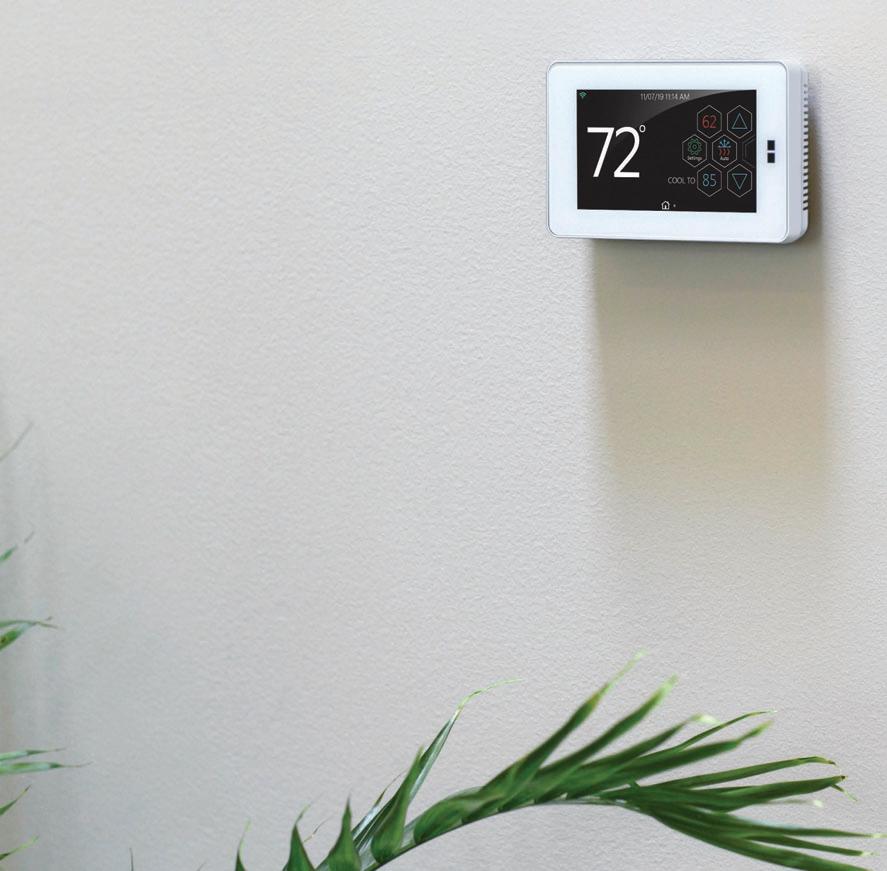
7 minute read
HVAC
from Jan/Feb 2022
Augmented reality can be used to train the next generation of technicians and help solve the labour shortage. By Glenn Mellors
There is not a lot changing within the HVAC world—a common comment overhead at HVAC contractor meetings around the country. I suppose that is true if you are running your business with your head down, trying to purchase equipment, finding a workforce to complete installations and service work that seems to never end. Pair those difficulties with the day-to-day challenges of purchasing personal protective equipment, following government protocols, and just trying to make a living. You’re right—nothing has changed from the view out your window.
Don’t get me wrong, this is not a criticism. This is life moving at a pace that we continued to struggle to keep up with. And to set the record straight, there is by no means enough
Thermostat technology will allow for any room in the home to be on its own zone, providing higher levels of comfort to the
homeowner. Photo provided by Johnson Controls
room in one article, let alone an entire magazine, to bring any of us up to speed on the evolving HVAC industry.
Little black box
About 10 years ago, we had hired a new director of marketing from outside the HVAC industry. He would proudly sashay around the office making predictions. One day, he came up to the team and said, “I predict that someday soon the box on the wall will not only control our comfort level but everything else we do as well.” We collectively laughed, but he got the last laugh.
Those little black, white, or round boxes can do an almost unlimited array of services for the end consumer, but what about the contractor? This little computer can communicate with the world, and within that, hopefully, your company. They are capable of self-diagnostics, booking service and maintenance visits, ordering replacement filters, playing music, looking up phone numbers, building an algorithm of your lifestyle, and even calling 911.Have you partnered yourself with the thermostats you’re selling? Are you the one it calls? Let us hope so!
Comfort everywhere
Easy comfort is now available in any room. Companies have released solutions that can maintain temperatures in even the toughest homes and connect to home’s Wi-Fi network. Did you ever sell residential zoning systems? Probably not, and why? They were a nightmare to install for the average furnace retailer, but now zone control is possible in any room. This HVAC technology solves the dramatic temperature differences between rooms that result in inefficient heating and cooling. Installation is quick and easy, takes roughly 15 minutes to complete, and offers greater comfort with 30 per cent more savings on energy.

What is old is new again
In our quest for greener homes, we seem to be forced to give up the luxuries that we have come accustomed to. Forced air heating and ventilation fans can account for a significant amount of the whole home’s electric usage. Companies and builders are working together to create ventilation systems that use more natural airflow, and specialized building materials provide a more constant building temperature which reduces the need for highpowered HVAC systems.
Brrr its cold in here
Willis Haviland Carrier would be delighted today that some of his inventions and theories are being explored and deployed once again— it takes 12,000 BTUs of energy to melt one ton of ice. This is the reason why the term “ton” is used in cooling instead of BTUs.
Ice Air, a company based out of the United States, is introducing new cooling technology based on revisited old technology. Their product will freeze 450 gallons or roughly 4,000 lbs of water in a tank overnight during what they refer to as “ice charging” mode. When demand for cooling exists, the unit switches to “ice-cooling” mode where the
Continued on page “29”
Continued from page “27”
two tons of ice is converted into cooling the exchanger, which powers the evaporator coil. In a typical application, it will provide six hours of air conditioning. Once the energy is no longer being converted, the call for cooling will prompt the conventional unit to take over. Ice Air intends to provide a reduction in total net energy costs.
Virtual training
A big shift in our industry, and arguably one of my favourite advancements, is the move to virtual training. Yet we are short the staff to train. A sk a ny HVAC or any skilled trades company, “Out of everything that is happening in our industry, what single thing has the greatest impact on your success?” I would be shocked if the first thing that comes to mind is not lack of skilled labour. Canada will face a 60,000-person shortage of skilled worker apprentices by 2025, according to the Canadian Apprenticeship Forum.
People power shortages are at an alltime high with skilled people power almost nonexistent. Provinces across the country are struggling to find a nswers t o t his q uestion. According to national statistics, young Canadians are not interested in joining the trades and it is a big problem. A recent report conducted by RBC Economics looked at the anticipated skilled worker shortage and found that over the next five years, Canada will face a shortage of at least 10,000 workers in the 56 Red Seal Trades. This squeeze can result in much higher costs for trades, which will mean costs will be passed along to the consumer.
Part of our frustration is that the industry is being supplied people that have taken HVAC programs, some as many as two full years of schooling, and yet to have touched a tool, let alone been in a real-life situation of standing in front of an HVAC appliance in need of repair. How many times have we had the perfect go-getter candidate that has not had the practical training needed to become an asset to our company?
Well, now there is a solution for that! The g reatest s trength t hat y oung p eople c an reapply in the skilled trades is their expertise
Virtual reality (VR) training allows for technicians to train anywhere in real life simulations.

in video gaming. Who would have thought that a video game expert could be the best trades candidate there is? Couple that talent with the latest in video virtual tradesperson training and we have the best candidate who can help advance our industry into the future.
Companies are springing up in the U.S. that offer complete NATE certified hands-on virtual training. With the use of Oculus Galaxy2 headsets and programs delivered by companies like Interplay learning, future technicians can complete installations, troubleshooting and make necessary repairs in 3D.
If we use the handheld controllers, we are virtually picking up tools, tightening wires, changing controls, and testing ourselves on our capabilities. Depending on your age, you may remember the game called Operation, whereby you performed a surgical operation with the use of tools. If you hit an edge around one of the vital organs, the patient’s nose would light up and it would figuratively die. Well, this type of training is Operation on steroids.
In most programs, the students are taken through the entire scenario from start to finish. During the second run-through, the student is verbally coached as they select the tools and fulfill the task. Once the student is comfortable, they go it alone and perform the task until they pass.
Each course is short and takes 20 minutes to complete. The students’ completion dates and scores are recorded on a dashboard. You will be able to monitor their skill improvement and be confident when sending them out onto a job site. The big plus is that if they get stuck, they can sign in, look up the task, and are walked through it again.
This new technology provides ample opportunity for every technician — no matter their level. So, next time someone asks what’s new in our industry, you can tell them a lot. :
Glenn Mellors was born into a plumbing family and started in the industry in 1973. He entered the HVAC side of the business in the 80s, working in wholesale, and then joined Lennox in 1992. In 2008 he joined the ClimateCare Cooperative Corporation, an Ontario contractor group, where he is director of training and implementation. Glenn can be reached at










